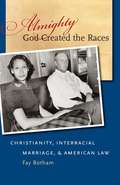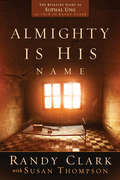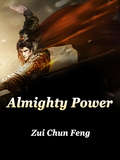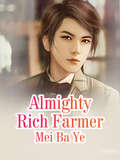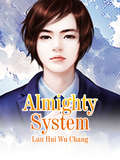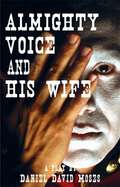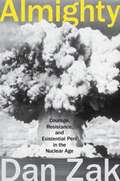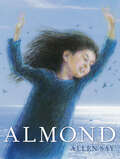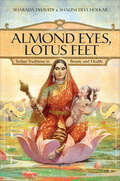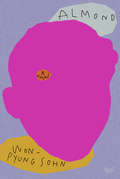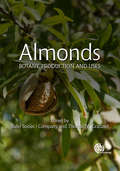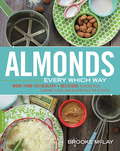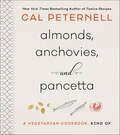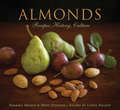- Table View
- List View
Almighty God Created the Races
by Fay BothamIn this fascinating cultural history of interracial marriage and its legal regulation in the United States, Fay Botham argues that religion--specifically, Protestant and Catholic beliefs about marriage and race--had a significant effect on legal decisions concerning miscegenation and marriage in the century following the Civil War. She contends that the white southern Protestant notion that God "dispersed" the races and the American Catholic emphasis on human unity and common origins point to ways that religion influenced the course of litigation and illuminate the religious bases for Christian racist and antiracist movements.
Almighty Is His Name: The Riveting Story of SoPhal Ung
by Randy ClarkAlmighty is His Name is the riveting story of God&’s hand of protection as missionary SoPhal Ung and his family fought for their lives in Cambodia. Although the Vietnamese invaded Cambodia in 1979, SoPhal started a house church, which grew from five members to six hundred in eight months. He was arrested for this &“illegal&” activity, imprisoned, severely beaten, and chained by hand and foot, losing seventy-five pounds in the terrible ordeal. God miraculously spared his life on numerous occasions. Later SoPhal fled with his wife and children to Thailand and spent ten years ministering to other Cambodian exiles. This page-turning narrative, recounted by Randy Clark founding director of Global Awakening, showcases an extraordinary kind of courage that was found in the heart of a man whose faith in Jesus Christ never wavered even in the face of unspeakable evil. SoPhal continues to train countless leaders, feed orphans, house and clothe the poor, and witness miracle upon miracle. For anyone seeking proof of God&’s greatness, this unforgettable true story will prove without a doubt that God is faithful.
Almighty Power: Volume 1 (Volume 1 #1)
by Zui ChunFeng"No, no …" "I'll just agree to marry you, I definitely won't marry you …" "How can you be like this? "You said that you truly like me, but to do such a thing to me, you will definitely die..." "Liu Lin, I beg you, don't! I agree to marry you …"
Almighty Rich Farmer: Volume 1 (Volume 1 #1)
by Mei BaYeThe village boy originally had no ambition. However, after being humiliated again and again by the village tyrant, he was forced to rise up and walk the path of village officials. This so-called blessed person was blessed by the heavens. With the help of the top-grade fox immortal, he could win every battle.
Almighty Rich Farmer: Volume 2 (Volume 2 #2)
by Mei BaYeThe village boy originally had no ambition. However, after being humiliated again and again by the village tyrant, he was forced to rise up and walk the path of village officials. This so-called blessed person was blessed by the heavens. With the help of the top-grade fox immortal, he could win every battle.
Almighty Rich Farmer: Volume 3 (Volume 3 #3)
by Mei BaYeThe village boy originally had no ambition. However, after being humiliated again and again by the village tyrant, he was forced to rise up and walk the path of village officials. This so-called blessed person was blessed by the heavens. With the help of the top-grade fox immortal, he could win every battle.
Almighty Rich Farmer: Volume 4 (Volume 4 #4)
by Mei BaYeThe village boy originally had no ambition. However, after being humiliated again and again by the village tyrant, he was forced to rise up and walk the path of village officials. This so-called blessed person was blessed by the heavens. With the help of the top-grade fox immortal, he could win every battle.
Almighty Soldier King: Volume 1 (Volume 1 #1)
by Fu ShengLove hate parting make a pair of fate bitter lovers after a few twists and turns they can get through the difficulties together plot he can overcome difficulties everything really as he wishes is it really that simple it seems that everything is a game in a game so their love can be verified they can hold hands is it really as easy as he imagined that there would be something hidden behind the plot will it really end this way perhaps everything is just the beginning but he knew that whatever the difficulties and crushed even to the heavens and the earth he will not have the slightest fear which he it is a let a person not afraid everything man obsessed by his story all of the answer to a riddle all in this book together let us explore the secret of the unknown
Almighty System: Volume 1 (Volume 1 #1)
by Lun HuiWuChangThere was nothing Heaven Descending Divine Cauldron couldn't do. Alchemy, treasure crafting, synthesis, roasting … After obtaining this miraculous Heavenly Cauldron, Du Dapeng was almighty and omnipotent. Not only did he possess superb strength, he even refined a cute pet to curry favor with the goddess … "Sigh... [Previous Chapter] [Table of Contents] [Next Chapter]
Almighty System: Volume 2 (Volume 2 #2)
by Lun HuiWuChangThere was nothing Heaven Descending Divine Cauldron couldn't do. Alchemy, treasure crafting, synthesis, roasting … After obtaining this miraculous Heavenly Cauldron, Du Dapeng was almighty and omnipotent. Not only did he possess superb strength, he even refined a cute pet to curry favor with the goddess … "Sigh... [Previous Chapter] [Table of Contents] [Next Chapter]
Almighty System: Volume 3 (Volume 3 #3)
by Lun HuiWuChangThere was nothing Heaven Descending Divine Cauldron couldn't do. Alchemy, treasure crafting, synthesis, roasting … After obtaining this miraculous Heavenly Cauldron, Du Dapeng was almighty and omnipotent. Not only did he possess superb strength, he even refined a cute pet to curry favor with the goddess … "Sigh... [Previous Chapter] [Table of Contents] [Next Chapter]
Almighty System: Volume 4 (Volume 4 #4)
by Lun HuiWuChangThere was nothing Heaven Descending Divine Cauldron couldn't do. Alchemy, treasure crafting, synthesis, roasting … After obtaining this miraculous Heavenly Cauldron, Du Dapeng was almighty and omnipotent. Not only did he possess superb strength, he even refined a cute pet to curry favor with the goddess … "Sigh... [Previous Chapter] [Table of Contents] [Next Chapter]
Almighty System: Volume 5 (Volume 5 #5)
by Lun HuiWuChangThere was nothing Heaven Descending Divine Cauldron couldn't do. Alchemy, treasure crafting, synthesis, roasting … After obtaining this miraculous Heavenly Cauldron, Du Dapeng was almighty and omnipotent. Not only did he possess superb strength, he even refined a cute pet to curry favor with the goddess … "Sigh... [Previous Chapter] [Table of Contents] [Next Chapter]
Almighty System: Volume 6 (Volume 6 #6)
by Lun HuiWuChangThere was nothing Heaven Descending Divine Cauldron couldn't do. Alchemy, treasure crafting, synthesis, roasting … After obtaining this miraculous Heavenly Cauldron, Du Dapeng was almighty and omnipotent. Not only did he possess superb strength, he even refined a cute pet to curry favor with the goddess … "Sigh... [Previous Chapter] [Table of Contents] [Next Chapter]
Almighty Voice and His Wife
by Daniel David MosesAlmighty Voice and His Wife shakes up a familiar story from the Saskatchewan frontier, reimagining it from the postmodern late twentieth century. The "renegade Indian story" transforms into both an eloquent tale of tragic love and an often hilarious, fully theatrical exorcism of the hurts of history. A modern classic about the place of First Nations people in Canada.
Almighty: Courage, Resistance, and Existential Peril in the Nuclear Age
by Dan ZakON A TRANQUIL SUMMER NIGHT in July 2012, a trio of peace activists infiltrated the Y-12 National Security Complex in Oak Ridge, Tennessee. Nicknamed the "Fort Knox of Uranium," Y-12 was supposedly one of the most secure sites in the world, a bastion of warhead parts and hundreds of tons of highly enriched uranium--enough to power thousands of nuclear bombs. The three activists--a house painter, a Vietnam War veteran, and an 82-year-old Catholic nun--penetrated the complex's exterior with alarming ease; their strongest tools were two pairs of bolt cutters and three hammers. Once inside, these pacifists hung protest banners, spray-painted biblical messages, and streaked the walls with human blood. Then they waited to be arrested. WITH THE BREAK-IN and their symbolic actions, the activists hoped to draw attention to a costly military-industrial complex that stockpiles deadly nukes. But they also triggered a political and legal firestorm of urgent and troubling questions. What if they had been terrorists? Why do the United States and Russia continue to possess enough nuclear weaponry to destroy the world several times over? IN ALMIGHTY, WASHINGTON POST REPORTER Dan Zak answers these questions by reexamining America's love-hate relationship to the bomb, from the race to achieve atomic power before the Nazis did to the solemn 70th anniversary of Hiroshima. At a time of concern about proliferation in such nations as Iran and North Korea, the U.S. arsenal is plagued by its own security problems. This life-or-death quandary is unraveled in Zak's eye-opening account, with a cast that includes the biophysicist who first educated the public on atomic energy, the prophet who predicted the creation of Oak Ridge, the generations of activists propelled into resistance by their faith, and the Washington bureaucrats and diplomats who are trying to keep the world safe. Part historical adventure, part courtroom drama, part moral thriller, Almighty reshapes the accepted narratives surrounding nuclear weapons and shows that our greatest modern-day threat remains a power we discovered long ago.
Almond
by Allen SayAlmond is a breathtaking and evocative story about finding your talent from Caldecott Medalist Allen Say.Everything changes for Almond Biggs when a new girl comes to school. The New Girl can play "The Flight of the Bumblebee" fast fast fast on her violin. And every day Almond sits and listens. Lost in the music, Almond wonders if she has her own unique gift. One special day, as Almond is watching the crows, circling and twirling in the wind, she realizes that she too can spread her wings and discovers the magic to being happy inside and out.Allen Say's luminous artwork and emotionally powerful story help children discover the wondrous gift of being who they are.
Almond Eyes, Lotus Feet: Indian Traditions in Beauty and Health
by Sharada Dwivedi Shalini Devi HolkarThe Indian bestseller. “A delightful pot-pourri of a book . . . far more than just a beauty book for women, it is also a repository of Indian culture.” —Charles Allen, internationally bestselling author of Plain Tales from the RajAlmond Eyes, Lotus Feet is the fictional memoir of a wise Indian princess, who recalls the ways the women of the Indian court found friendship, faith, and love through their beauty traditions. We journey with her as she recounts a lifetime of comforting rituals, tantalizing textures, colors, and fragrances, exquisite jewels and adornments, and assorted beauty and health secrets passed through generations of women by word of mouth.In Almond Eyes, Lotus Feet, Sharada Dwivedi, a native of India, and Shalini Devi Holkar, an Indian princess by marriage, draw on the oral histories of privileged Indian women to capture and revive their many wonderful and wise beauty traditions. The result is a rich cultural tapestry, filled with ancient remedies, recipes, and tonics used to soften skin, silken hair, enrich the body, and lift the spirit like no store-bought products can. Additionally, the book offers a glossary of plants, flowers, spices, and grains and simple home remedies for women in all stages of life—from puberty to pregnancy to menopause—including:Almond-Saffron for cleansing and exfoliationPapaya-Mint Tea for acne and pimplesCream & Honey for dry skin and wrinklesCress & Rosewater for post-natal strengthTulsi Kadha (Basil Tea) for coughs or morning sicknessReplete with gorgeous photos and illustrations from a bygone era, Almond Eyes, Lotus Feet is a treasure trove of time-honored health and beauty customs that will delight the senses of modern women everywhere.
Almond: A Novel
by Won-pyung SohnThe Emissary meets The Curious Incident of the Dog in the Nighttime in this poignant and triumphant story about how love, friendship, and persistence can change a life forever.This story is, in short, about a monster meeting another monster. One of the monsters is me.Yunjae was born with a brain condition called Alexithymia that makes it hard for him to feel emotions like fear or anger. He does not have friends—the two almond-shaped neurons located deep in his brain have seen to that—but his devoted mother and grandmother provide him with a safe and content life. Their little home above his mother’s used bookstore is decorated with colorful Post-it notes that remind him when to smile, when to say "thank you," and when to laugh.Then on Christmas Eve—Yunjae’s sixteenth birthday—everything changes. A shocking act of random violence shatters his world, leaving him alone and on his own. Struggling to cope with his loss, Yunjae retreats into silent isolation, until troubled teenager Gon arrives at his school, and they develop a surprising bond. As Yunjae begins to open his life to new people—including a girl at school—something slowly changes inside him. And when Gon suddenly finds his life at risk, Yunjae will have the chance to step outside of every comfort zone he has created to perhaps become the hero he never thought he would be.Readers of Wonder by R.J. Palaccio and Ginny Moon by Benjamin Ludwig will appreciate this "resonant" story that "gives Yunjae the courage to claim an entirely different story." (Booklist, starred review)
Almonds
by Rafel Socias i Company Thomas M. GradzielThis book provides a comprehensive overview of almond growing from a scientific and horticultural perspective, covering botany, production, processing and industrial uses. Almonds are an important crop; they are highly regarded for their flavour, nutritional properties and culinary uses, and almond oil is used widely in food, cosmetic and pharmaceutical production. They are easy to transport and have long storability, facilitating global dissemination. Demand is constantly increasing and global production has more than doubled in the last 20 years. The popularity of almonds and the increase in demand has required new plantings and a response to ongoing changes in cultural and climatic conditions. Almonds: Botany, Production and Uses meets the need for up-to-date information on this crop and covers: #65533; botany and taxonomy #65533; cultivation, genetics and breeding #65533; propagation, orchard management and harvesting #65533; pests and diseases #65533; nutrition, marketing and utilization Authored by an international team of experts and presented in full colour throughout, this book is an essential resource for academic researchers and extension workers, as well as growers, orchard managers and industry personnel.
Almonds Every Which Way: More than 150 Healthy & Delicious Almond Milk, Almond Flour, and Almond Butter Recipes
by Brooke MclayAlmonds are everywhere, and with good reason! Full of vitamin E, magnesium, protein, fiber, calcium, and more, this superfood delivers lots of health benefits in a delicious little package. When almonds are made into grain-free flour, non-dairy milk, and nut butter, these easy alternatives to wheat flour, dairy, and peanut butter support a variety of diets--vegan to gluten-free, vegetarian to Paleo. Whether you're following a particular way of eating or just looking to add variety to your cooking, Almonds Every Which Way offers key info for incorporating more nutritious foods into your diet, including:Basic recipes for homemade almond milks, butters, and floursEasy tips and tricks for using and storing almond ingredientsNutritional info for each recipeDesignations for gluten-free, allergy-free, dairy-free, vegetarian, vegan, and Paleo optionsAnd, of course, the recipes: you'll find more than 150 scrumptious almond-based dishes, from breakfast favorites like smoothies, pancakes, and croissants, to sandwiches, snacks, and easy, family-pleasing entrees like fish tacos and vegan "neatloaf." With Almonds Every Which Way, you'll have every diet, meal, and taste bud covered.
Almonds and Raisins (Almonds and Raisins)
by Maisie MoscoA family&’s survival depends on their unbreakable bond. First in the trilogy of new beginnings and lasting dreams from the &“undisputed queen of her genre&” (The Jewish Chronicle). The Sandberg family arrive in England having fled Russia to avoid persecution. It is 1905, and in their new home of Manchester they soon discover that hardships can come in many forms. It&’s a friendship with their neighbors, the Moritz family, that finally makes them feel at ease. As the two families become increasingly intertwined, it is eldest son David who finds the culture of his new country encourages him to rebel against his mother&’s wishes. Sarah Sandberg has ruled the family with a quiet authority but now faces the challenge of a son who wants to shake off duty in his own desire for love and freedom. In the years ahead, the Sandbergs will face even greater challenges. It is only their enduring spirit that sees them overcome the odds to find sanctity, and even joy, as they survive each twist and turn of life. A much-loved novel from an internationally bestselling author, perfect for fans of Emma Hornby and Sheelagh Kelly. Praise for the writing of Maisie Mosco &“Once in every generation or so a book comes along which lifts the curtain.&” —The Guardian &“Full of freshness and fascination.&” —Manchester Evening News
Almonds, Anchovies, and Pancetta: A Vegetarian Cookbook, Kind Of
by Cal Peternell2019 James Beard Award NomineeFrom the author of the New York Times bestselling, IACP Award-winning Twelve Recipes comes a charming vegetable-focused cookbook with sixty recipes that add depths of flavor using three key ingredients: almonds, anchovies, and pancetta.Celebrated chef and home cook Cal Peternell likes to eat today the way people have been eating forever: with vegetables at the center of the plate, seasoned with a little bit of meat or fish to make a meal savory and satisfying. A little of the right kind of meat goes a long way, and in this book, the right ones are anchovies and pancetta, along with almonds, because nuts are the meat of the plant world. Cal uses them first for flavor, but also because it makes sense: taking savory little bites is inarguably better than big meaty mouthfuls. The salt in anchovies and pancetta draws out and enhances flavors, enriching the rest of the dish, and almonds compare favorably fat-wise and can bring a major flavor boost, especially when they’re ground up. This kind of cooking is healthy, leans toward sustainability, and is economical in a way that pleases both palate and pocketbook.The simple, flexible recipes in this book include Baked, Stuffed Vegetables with Almonds, Currents, Saffron, and Breadcrumbs; Steamed Clams with Almond and Parsley Butter; Roasted Sweet Pepper and Egg Salad with Anchovies, Olives, and Capers; Penne alla Tuna-nesca; Bacon-wrapped Potato Gratin; and Creamy Salsa Rustica with Egg and Pancetta. Cal’s old-new way with vegetables gives them small gifts of tasty goodness that will inspire readers to their own mealtime creativity.
Almonds: Botany, Production and Uses (Botany, Production and Uses)
by Patrick Brown Gregory Reighard Mariano Cambra James Adaskaveg Robert Curtis Vicente Pallás José M Alonso José M Ansón Octavio Arquero Roger A Baldwin Ignasi Batlle Mireia Bordàs Miguel A. Cambra Joseph H. Connell Federico Dicenta David A. Doll Henri Duval Iban Eduardo Daniel Esmenjaud José L Carbó Maria T Espiau Antonio J. Felipe Angel Fernández i Martí Carolina Font i Forcada Helga Förster Luis Iannamico Santiago Izquierdo Sat Darshan Khalsa Ossama Kodad Maria M. López Carmen Martínez Pedro Martínez-Gómez Saiful Muhammad Eva Núñez Seoane Antonio Olmos Ana Palacio-Bielsa Katherine Pope Maria J Rubio-Cabetas Ned T. Ryan Sebastián Sáa Silva Raquel Sánchez-Pérez Francisco J. Vargas Steve Weinbaum Michelle Wirthensohn Shu-Biao Wu Frank G Zalom Alexis VerdúThis book provides a comprehensive overview of almond growing from a scientific and horticultural perspective, covering botany, production, processing and industrial uses. Almonds are an important crop; they are highly regarded for their flavour, nutritional properties and culinary uses, and almond oil is used widely in food, cosmetic and pharmaceutical production. They are easy to transport and have long storability, facilitating global dissemination. Demand is constantly increasing and global production has more than doubled in the last 20 years. The popularity of almonds and the increase in demand has required new plantings and a response to ongoing changes in cultural and climatic conditions. Almonds: Botany, Production and Uses meets the need for up-to-date information on this crop and covers: · botany and taxonomy · cultivation, genetics and breeding · propagation, orchard management and harvesting · pests and diseases · nutrition, marketing and utilization Authored by an international team of experts and presented in full colour throughout, this book is an essential resource for academic researchers and extension workers, as well as growers, orchard managers and industry personnel.
Almonds: Recipes, History, Culture
by Barbara Bryant Betsy Fentress Lynda BalslevA treasury of information and &“simple and creative&” recipes that make the most of this delicious, nutritious nut (Daniel Boulud, chef and restaurateur). From the anatomy of a nut to the history of the almond in world culture, the cultivation of almond orchards in California, and nutrition provided by a favorite nut, this book provide a wealth of information about the versatile, high-protein, diet-friendly almond—along with numerous recipes that incorporate this scrumptious ingredient in snacks, starters, salads, pasta dishes, entrees, and desserts. Try over 50 recipes including Soba Noodles with Spicy Almond Butter Sauce · Almond-Crusted Pork Chops with Sweet-and-Sour Apricot Glaze • Lamb Tagine with Apricots, Almonds and Honey • Almond Florentine Cookies • Chocolate-Amaretto Torte • Moroccan Rice Pudding • Chocolate-Almond Bark • and moreIncludes photos
